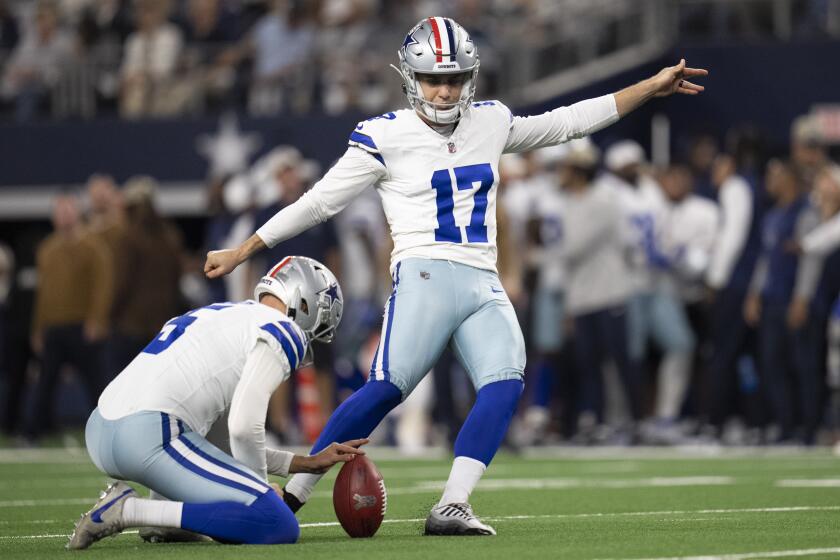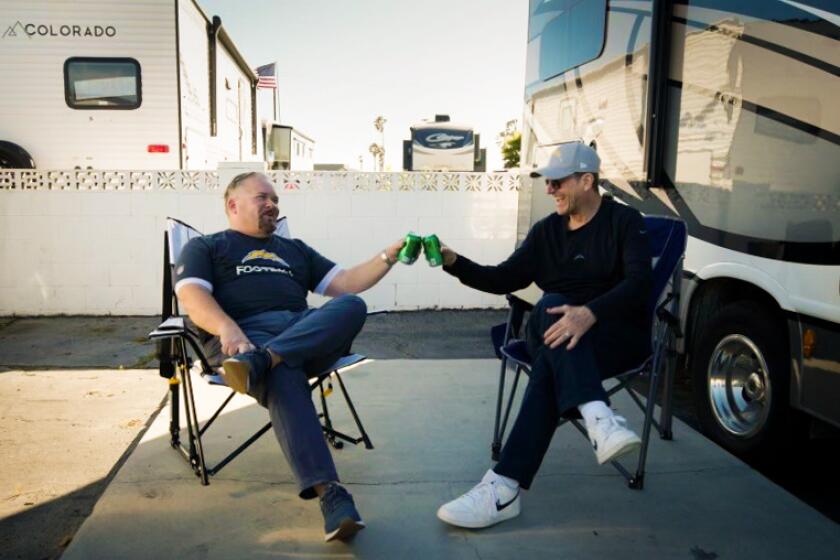- Share via
- Share via
Peering into the distance, Joshua Karty needs a few seconds to settle himself. He stands up a little taller and takes a deep breath.
His job as an NFL kicker might seem obvious at this particular moment: He has to boot the football far enough and straight enough to make a 48-yard field goal. But it isn’t quite that simple.
The Rams rookie also needs a good snap, fast and on-target. He needs the holder to catch it cleanly, set it down and apply the desired tilt. Karty will already be striding forward by then, taking two measured steps, head down, eyes focused on where the ball should end up.
“You just trust that your holder is going to put it in that exact spot,” he says. “You just swing through where that spot is.”
The whole process — from snap to kick — ideally transpires in 1.3 seconds or less. Three separate players must orchestrate three different tasks and seemingly countless tiny details as a bunch of large, strong men from the other team charge at them from across the line.
So, as Karty prepares for a second-quarter attempt against the San Francisco 49ers, hoping to tie the game before halftime, he and his teammates double-check their to-do lists. The snapper, Alex Ward, wonders if fans appreciate the complexity involved.
“Mayhem,” Ward calls it. “Controlled mayhem.”

This has been a weird season for NFL kickers.
So far, they have made about 72% of their tries from 50 or more yards, a big improvement from 58% five years ago. Brandon Aubrey of the Dallas Cowboys has made two from 60 or more.
But pro kickers have also misfired on crucial kicks from shorter range. That includes future Hall of Famer Justin Tucker of the Baltimore Ravens. Also, Karty.
Early on, Karty hit a 52-yarder against the Chicago Bears and had five field goals, including kicks of 53 and 55 yards, against the Miami Dolphins.
California residents Jim Tunney and Al Jury, both of whom recently died, were two of the most-respected NFL officials during their careers on the gridiron.
Then came a month of more misses than makes, with a botched extra-point attempt against the Buffalo Bills and a 26-yarder that clanged off the right goalpost in New England.
As Karty slipped down the rankings for NFL kickers with a 77% efficiency rate, coach Sean McVay grew openly frustrated, and there was online speculation the Rams might sign a midseason replacement.
Special teams coordinator Chase Blackburn preached patience, saying: “We’ve got to work through it.”
By mid-December, the Rams needed a victory over division-rival San Francisco to remain in playoff contention. Karty, Ward and holder Ethan Evans, who also serves as punter, got back to basics at practice.
Each player focused on the nuances of his role — snap, hold, kick — breaking it down to tenths of a second.
Absolute zero. That’s how Ward describes his job, the place where it all starts.
The snapper begins by setting his feet wide and hunkering down, making sure his butt isn’t too high or too low. Grasping the ball, he pulls it a few inches closer, almost under his face, then gives it a twist.
His left hand now rests on top of the ball, with his right curled underneath, so he can impart more spin.
Proper technique should translate into a snap that travels eight yards back to Evans with nearly identical speed — arriving in a little more than five-tenths of a second — every time. Rotation is crucial because the ball should hit the holder’s hands with the laces facing between 10 and 2 o’clock.

There is no cookie-cutter technique, so doing this consistently requires lots of trial and error, tinkering, determining what works best.
“Every snapper has to find either the range or the speed of revolution to get the laces up,” Ward says. “You drill it so much into muscle memory.”
After getting set, Ward looks back through his legs, waiting for Karty to nod. This is his cue to begin exhaling, mindful that the amount of air in his lungs will affect the degree to which his body curls and the force he imparts on the snap.
“I exhale three-quarters,” he says. “So that I can follow through to the same point and control another, you know, aspect of the distance.”
Not every snap is perfect. His stance or release might vary an inch, his elbows might wander slightly off track. “So many variables,” he says. Even small discrepancies can make a difference.
That’s where the holder comes in.
It used to be that quarterbacks doubled as holders, a side job that exposed them to injury and also pulled them out of offensive drills to practice with special teams. Punters eventually inherited the role.
Drafted by the Rams in 2023, Evans had to adjust because, as both punter and kicker at tiny Wingate University in North Carolina, he had no college experience with holding. The first task? Improve his hands by catching ball after ball fired at him by a Jugs machine.
Evans soon grew accustomed to the required body position, tucking his right leg underneath him and pulling his left knee close to his chest, staying clear of the kicker’s swing path. He learned to touch his left elbow to the inside of his left knee before reaching out for the snap.
“When I catch the ball and bring it back, when my elbow hits my knee, I know that I’m going to hit the spot,” he says.
Dallas Cowboys standout kicker Brandon Aubrey played soccer before making the move to kicking footballs. He isn’t the first soccer player to shine in the NFL.
His chest twists a bit awkwardly, facing the line of scrimmage, so he can reach in any direction. As Ward explains, the snap “could be high, could be low, could be back-shoulder. [Evans] is going to take whatever error I have and minimize it.”
That means catching the ball and making quick adjustments.
Kickers want the laces facing the goalposts for a truer flight. If Evans receives the snap with laces up, he can simply set it on the ground. If not, he must feel for the laces with his hands, determining whether to spin the ball one way or another.
Then comes the tilt. Karty prefers a little forward, a little to the right. “Whatever the kicker wants,” Evans says.
There is roughly half a second before contact.
In the moments before each attempt, Karty checks the wind and searches for a target.
“I choose a point in the background, behind the field-goal uprights,” he says. “Whether it’s, like, a sign up there, way up in the stadium, or … a pole or a cloud or something.”
Taking three steps back and two to the left, he points his left foot toward the spot where it will plant beside the ball. Then comes one last glance at the target, that deep breath and a nod to let everyone know he is ready.
The moment Evans taps the ground, calling for the snap, the kicker must take his first step.

“You can’t wait for the holder to catch it before you start,” Karty says. “It’s all about finding the rhythm and the tempo and the consistency of trying to get exactly 1.3 seconds for every single kick.”
If all goes well, the ball will be placed on the ground a half-second before his foot swings through. An errant snap or muffed catch can delay placement by one- or two-tenths of a second. Karty says: “I just get less time to see the ball … which is a big difference.”
Placement also matters.
“An inch closer … you have a jammed plant foot,” Karty says. “If he misses the other way, then you’re going to be reaching for the ball.”
There was at least one reason for Karty’s slump over the past month. A flaw had wormed its way into his technique at the start of those 1.3 seconds.
“He left early, got quick and expedited it, which just adds an element of not being able to see the ball down as long,” Blackburn says. “You rush into it, your leg doesn’t quite catch up.”
Adrenaline can do that to a kicker with thousands of fans in the stadium and millions more watching on television. Anyone looking closely could see Karty trying to calm himself before the 48-yard attempt against the 49ers.
Setting his feet just right. Straightening up. Breathing deeply.
Despite a steady downpour at Levi’s Stadium, Ward delivered an accurate snap and Evans did his job on the hold. A San Francisco rusher got a fingertip on the ball but it sailed through the goalposts with more than enough distance.
Jim Harbaugh lived in an RV at the beach after the Chargers hired him as coach in a move reminiscent of James Garner’s character in “The Rockford files”.
“Sometimes you just need a little luck,” Karty says. “I think I was due.”
Neither team could generate much offense on a slippery night, so the Rams called upon their kicker three more times in the second half. He accounted for all of his team’s points in a 12-6 victory, putting an end to his struggles. At least temporarily.
“Stuff happens in football and it’s a long season,” he says. “You just keep chugging along.”
When it comes to launching a football through distant uprights, the next miss is just one bad snap, one fumbled hold and one-tenth of a second away.
More to Read
Go beyond the scoreboard
Get the latest on L.A.'s teams in the daily Sports Report newsletter.
You may occasionally receive promotional content from the Los Angeles Times.















